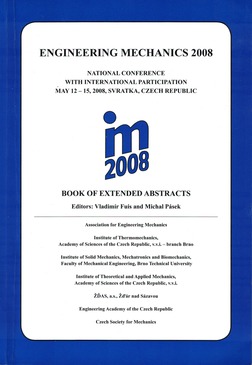Proceedings Vol. 14 (2008)

ENGINEERING MECHANICS 2008
May 12 – 15, 2008, Svratka, Czech Republic
Copyright © 2008 Institute of Thermomechanics, Academy of Sciences of the Czech Republic, v.v.i., Prague
ISSN 1805-8248 (printed)
ISSN 1805-8256 (electronic)
list of papers scientific commitee
pages 70 - +7p., full text
“Performance-Based Design” (PBD) is based on the theory of probability which is connected with statistics. PBD is also based on the performance requirements which are usually defined as a synthesis of functionality, all-in cost, safety etc. Performance requirements can be expressed as an acceptable level of damage, which is defined by acceptable probability of possible failure. In the following example is used SBRA method (SimulationBased Reliability Assessment Method, direct Monte Carlo Method, AntHill software). A shaft of unknown circular shape is exposed to bending moment, normal force and torque, which are given by truncated histograms. Yield limit of the material is also given by truncated histogram. The task is to calculate the nominal value of diameter which is given by normal truncated distribution ± 1 % . The acceptable level of damage is related to the yield limit. The calculation of the diameter, with given acceptable probability of damage level (i.e. solution of the inverse problem of theory of probability), must be solved via iterative approaches (secant method, bisection method etc.). Hence, to get the solution of this type of inverse problem is much difficult than the solution of the classical problem of theory of probability. Introduction In the last several decades, the science and engineering community has progressively ventured outside of traditional boundaries in terms of materials, loads, configurations etc. for structural systems in mechanics. Consequently, a new designer's approach called Performance-Based Design (PBD) can be defined as: “Design specifically intended to limit the consequences of one or more perils to defined acceptable
back to list of papers
Text and facts may be copied and used freely, but credit should be given to these Proceedings.
All papers were reviewed by members of the scientific committee.

 Powered by
Imce 3.20 © 2023, Pavel Formánek, Institute of Thermomechanics AS CR, v.v.i. [generated: 0.0114s]
Powered by
Imce 3.20 © 2023, Pavel Formánek, Institute of Thermomechanics AS CR, v.v.i. [generated: 0.0114s]